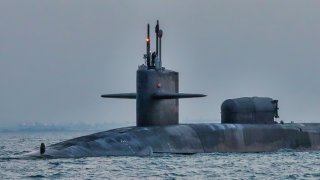Unprecedented: The Navy 'Telegraphed' It was 'Rushing' Ohio-Class Submarine to Iran's Doorstep
The USS Georgia, an Ohio-class guided missile submarine (SSGN), is being deployed to the Middle East amid concerns of potential Iranian attacks on Israel. The odd thing about it: the Navy announced it to the world.
Summary and Top Points You Need to Know: The USS Georgia, an Ohio-class guided missile submarine (SSGN), is being deployed to the Middle East amid concerns of potential Iranian attacks on Israel. The odd thing about it: the Navy announced it to the world.
Why Do This? Initially operating in the Mediterranean, the submarine, armed with up to 154 Tomahawk missiles, is being sent to the Red Sea or Persian Gulf to bolster U.S. military presence and deter Iranian aggression.
Bottom line: This deployment is part of a broader U.S. strategy that includes sending additional naval forces to the region, highlighting the significance of the Ohio-class SSGNs in U.S. military strategy, particularly in high-tension areas like the Middle East.
Ohio-Class SSGN USS Georgia Being Deployed to the Middle East
The point of the United States Navy's submarine fleet is that an adversary isn't supposed to know where the boats are at any given time. The nuclear-power vessels have unlimited range and can stay submerged for weeks, even months at a time if necessary.
Yet, this week, the U.S. Navy announced that the USS Georgia was among the vessels being "rushed" to the Middle East to beef up the U.S. military presence in anticipation that Iran and its proxies could launch an attack on U.S. ally Israel at any moment. U.S. Secretary of Defense Lloyd J. Austin issued the order on Sunday.
USS Georgia (SSGN-729) was reportedly operating in the Mediterranean when the order came for her deployment to the Red Sea or Persian Gulf. The announcement that the U.S. was sending a submarine – which is armed with cruise missiles that could strike targets throughout the Middle East – was likely to deter Tehran from carrying out any strikes against Israel.
It was just last week that the U.S. Naval Forces Europe Africa/U.S. 6th Fleet also announced the SSGN-729 had "concluded a series of interoperability training events with Force Reconnaissance Marines from the 2nd Reconnaissance Battalion and special operations forces (SOF) in the Mediterranean Sea" and was conducted "to improve U.S. Marine Corps and SOF integration with conventional naval forces in order to develop and improve tactics, techniques and procedures."
The boat won't be alone.
In addition to the Ohio-class guided missile submarine, Austin also the USS Abraham Lincoln Carrier Strike Group (CSG) to accelerate its transit to the U.S. Central Command (CENTCOM) area of responsibility, to support the USS Theodore Roosevelt CSG already in the region. This will be the first time that two U.S. Navy nuclear-powered supercarriers have operated in the Middle East since USS Gerald R. Ford (CVN-78) returned to the United States earlier this year after seeing her deployments extended to remain in the waters of the Eastern Mediterranean while USS Dwight D. Eisenhower (CVN-69) was sent to the Red Sea.
A Guided Missile Boat
USS Georgia is one of the 18 Ohio-class nuclear-powered ballistic missile submarines (SSBNs) that were built for the U.S. Navy between 1976 and 1997, and one of the four converted to an SSGN per the Strategic Arms Reduction Treaty (START II).
That treaty, which was agreed in June 1992, limited the number of U.S. Navy strategic missile submarines to 14 beginning in 2002. The Department of Defense made the decision to convert the four oldest boats of the class, including SSBN-729, into a cruise missile submarine.
Though no longer part of the U.S. military's nuclear triad, the SSGNs should still be seen as extremely well-armed vessels, one that should give Tehran pause.
During the conversion process, the four SSBNs had their 24 missile tubes that held Trident Submarine Launched Ballistic Missiles (SLBM) removed and replaced with 22 missile tubes that could hold seven Tomahawk Land Attack Missiles (TLAM) each, for a total of 154 missiles.
In addition, the converted submarines were also given the space and necessary changes to host up to 66 Special Forces (SOF) personnel and two missile tubes modified to lockout-out chambers for Dry Deck Shelter (DDS), while the conversion also resulted in these vessels trading their SLBM control related facilities for the Common Submarine Radio Room (CSRR) and two High-Data-Rate antennas. That greatly expanded the communication capabilities of the vessels and each was essentially equipped with the necessary systems to act as a forward-deployed Small Combatant Joint Command Center for the Special Forces onboard.
Whether the SSGN would be employed to launch missiles at Iran or its proxies or conduct some sort of Special Forces operation should be taken very seriously by Tehran. Once the USS Georgia is in the region, it will likely have its crosshairs set on key targets.
As Brandon J. Weichert wrote for The National Interest, "(The Ohio-class SSGN) submarine is an undersea juggernaut, brimming with a vast and lethal arsenal and one of the world’s most sophisticated undersea communications suites, the Ohio-class will be one of the most important weapons systems the US Navy can deploy against the Chinese military in war." The same holds true for Iran – and perhaps even more so.
Author Experience and Expertise: Peter Suciu, Defense Expert
Peter Suciu is a Michigan-based writer. He has contributed to more than four dozen magazines, newspapers, and websites with over 3,200 published pieces over a twenty-year career in journalism. He regularly writes about military hardware, firearms history, cybersecurity, politics, and international affairs. Peter is also a Contributing Writer for Forbes and Clearance Jobs. You can follow him on Twitter: @PeterSuciu. You can email the author: [email protected].
Image Credit: U.S. Navy.


